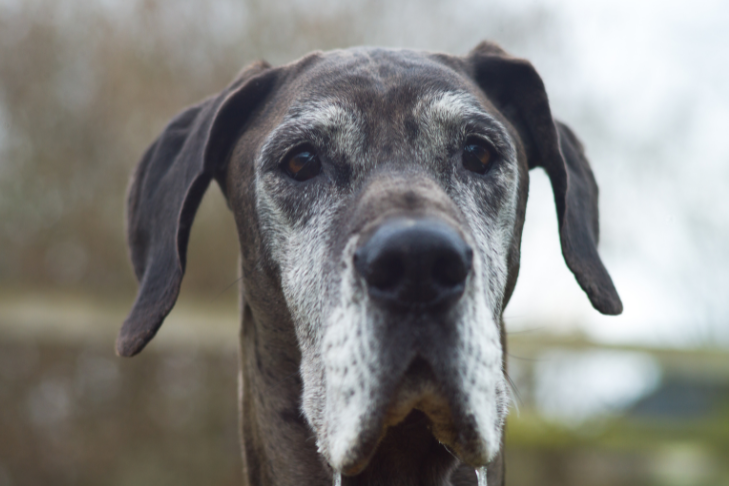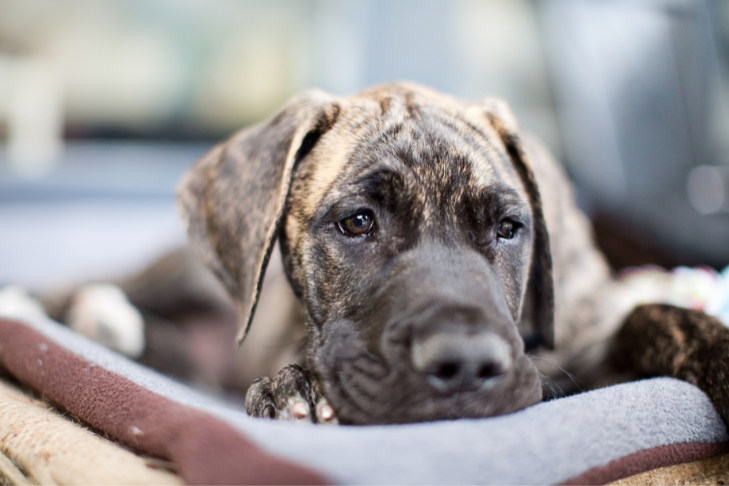Great Dane Life Span and Common Health Issues

Your Great Dane isn’t just a dog — they’re a loyal companion, a gentle giant, and a true member of the family. Whether they’re lounging on the couch like they own the place or impressing everyone with their polite manners and playful energy, it’s easy to see why these dogs are so beloved. Great Danes may be massive in size (often tipping the scale at over 100 pounds), but they’re known for being affectionate, easygoing, and eager to please.
Because they’re such an important part of your life, it’s natural to wonder about their long-term health. How long do Great Danes live? And what are the most common Great Dane health issues to watch out for? In this blog, we’ll cover the typical Great Dane lifespan, the health problems this breed is prone to, and what you can do to help your pup live a long, happy, and healthy life.
How Long do Great Danes Live?
The Great Dane life expectancy is between 8-10 years, according to the American Kennel Club (AKC). Some Great Danes only make it to 6 or 7 years, while 12 is considered ancient for a Great Dane. The AKC goes on to say that, with their giant frames, Great Danes are more likely to develop joint and bone diseases, like hip dysplasia and arthritis. While these diseases are technically not life-threatening, they can be extremely painful and debilitating, which then means the owner must make a decision about their dog’s quality of life. Scientists do not yet know why larger dog breeds tend to live shorter lives compared to their smaller counterparts.
Common Great Dane Health Problems
Bloat
Bloat, or gastric dilation-volvulus complex (GDV), is a medical emergency that requires surgery. Bloat happens when the stomach fills with air, causing pressure to build. Blood flow is blocked from the back end of the body, which sends the dog into shock. Dogs must receive medical treatment for this condition. Signs and symptoms of bloat include:
- An enlarged abdomen or belly
- Retching, particularly if it’s dry or becomes dry
- Excess salivation
- Restlessness
- Whining or other signs of pain when you press on the belly
If your dog is showing these symptoms, take them to an emergency vet clinic right away.
Hip dysplasia
Hip dysplasia is a joint condition that affects the ball and socket hip joint. It’s caused by these joints developing improperly, and this is often simply rooted in genetics. With hip dysplasia, the ball and socket of the hip joint don’t fit together correctly, which leads to painful grinding of the joint. This wears out the protective cartilage and can eventually lead to lameness.
Cardiomyopathy
This is a condition that leads to an enlargement of a dog’s heart. This is one of the most common heart diseases in dogs. It’s more common as dogs age and will eventually lead to congestive heart failure. Take your dog to the vet if you notice him slowing down and disliking exercise, has cold feet, coughing, appears pot-bellied, has less appetite, has a blue tongue, and labored breathing.
Cataracts
Cataracts are an eye condition that can develop as a dog ages. The lens of the eye starts to become cloudy due to a build-up of proteins. These proteins create a film over the eye, blocking light and may eventually lead to blindness. Depending on your dog’s health, surgery might be able to reverse cataracts.

How to Improve Your Great Dane’s Health and Lifespan
Whether you’re already the proud parent of a Great Dane or you’re considering bringing one home, there are a number of ways you can support their well-being.
If you haven’t adopted yet, looking for a responsible, ethical breeder is an important first step in giving your dog the healthiest start possible. And if you already have your Great Dane at home, the rest of this guide is packed with lifestyle tips to help keep your gentle giant thrive for years to come.
Responsible breeding
Choosing a responsible dog breeder is important, not only for the health of your dog but also for the health of the breed as a whole. Here are a few ways to tell if you’ve found a responsible breeder or not.
- The breeder is familiar with Great Dane breed standards.
- Their parent dogs are healthy with the medical records to prove it.
- They only breed registered Great Danes.
- They don’t sell their puppies to pet shops.
- They keep all the puppies together until at least 7 or 8 weeks of age.
- They follow any applicable state and local laws concerning the sale of puppies.
- Their puppies have medical records of immunization and parasite control along with written instructions regarding the dog’s care.
- They interview you to make sure you’re able to provide a good home for their dog.
Nutrition
Great Danes can benefit from being fed several small meals throughout the day. This helps to prevent the deadly bloat this breed is prone to. If you are gone most of the day for work, then consider an automatic dog feeder with a timer.
Feeding your Great Dane a high-quality diet is one of the best ways to keep your dog healthy and prevent health issues in the future. One way to find good dog food is to look for “meat” as the first ingredient. Here are a few things to avoid when choosing dog food.
- Grain as the first ingredient – While some grains are fine, they shouldn’t dominate the formula.
- Meat by-products – These are lower-quality animal parts like organs, feet, or feathers.
- Beef tallow & animal fat – Look for specified, nutritious fats like chicken or turkey fat instead.
- Food fragments – Avoid vague fillers like “mill run” or “cereal fines,” which add little nutritional value.
- Sugars & sweeteners – Ingredients like corn syrup, molasses, or xylitol are unnecessary and unhealthy.
- Animal digest – A vague mix of animal parts used for flavoring—generally best to steer clear.
- Artificial coloring – These serve no benefit for dogs and are used to appeal to humans.
- Hydrochloric acid – Indicates the food is hard to digest and likely low quality.
Exercise
Making sure your Great Dane gets plenty of exercise, is a great way to keep her happy and healthy. Try to exercise her on softer surfaces like dirt or grass to prevent strain on her joints and bones. Great Danes do well with 30-60 minutes of exercise a day. Because of their issues with bloat, do not exercise after they’ve eaten a meal.
Grooming
Great Danes are easy dogs to keep groomed. Most of the year, a weekly brush with a medium-bristle brush or a rubber grooming mitt will help cut down on the shedding. However, Great Danes do have a shedding season once or twice a year and will benefit from daily brushing during this time.
5. Veterinary care
Take your Great Dane in for his yearly checkups with the vet. This allows your vet to keep an eye on your Great Dane’s health and catch any health issues before they become problems. Of course, if your dog is sick, make an appointment right away.
6. Supplements
Nutritional supplements can be a helpful way to support your dog’s overall health, especially as they age. There are many different types of supplements available, and the right ones will depend on your dog’s size, age, and specific health needs. It's always best to talk to your veterinarian about whether supplements might be a good addition to your dog’s routine and which ingredients or products to look for.


